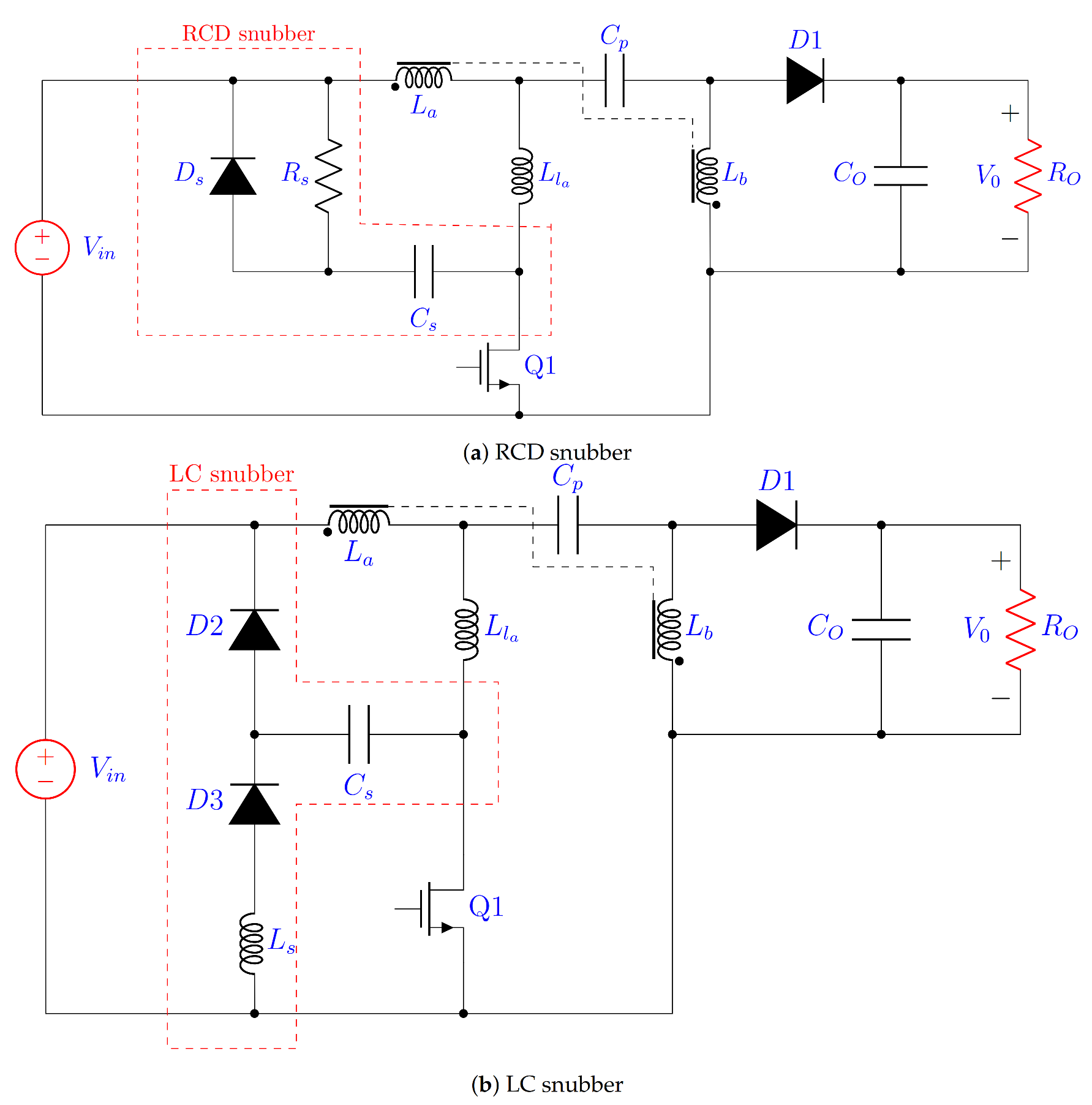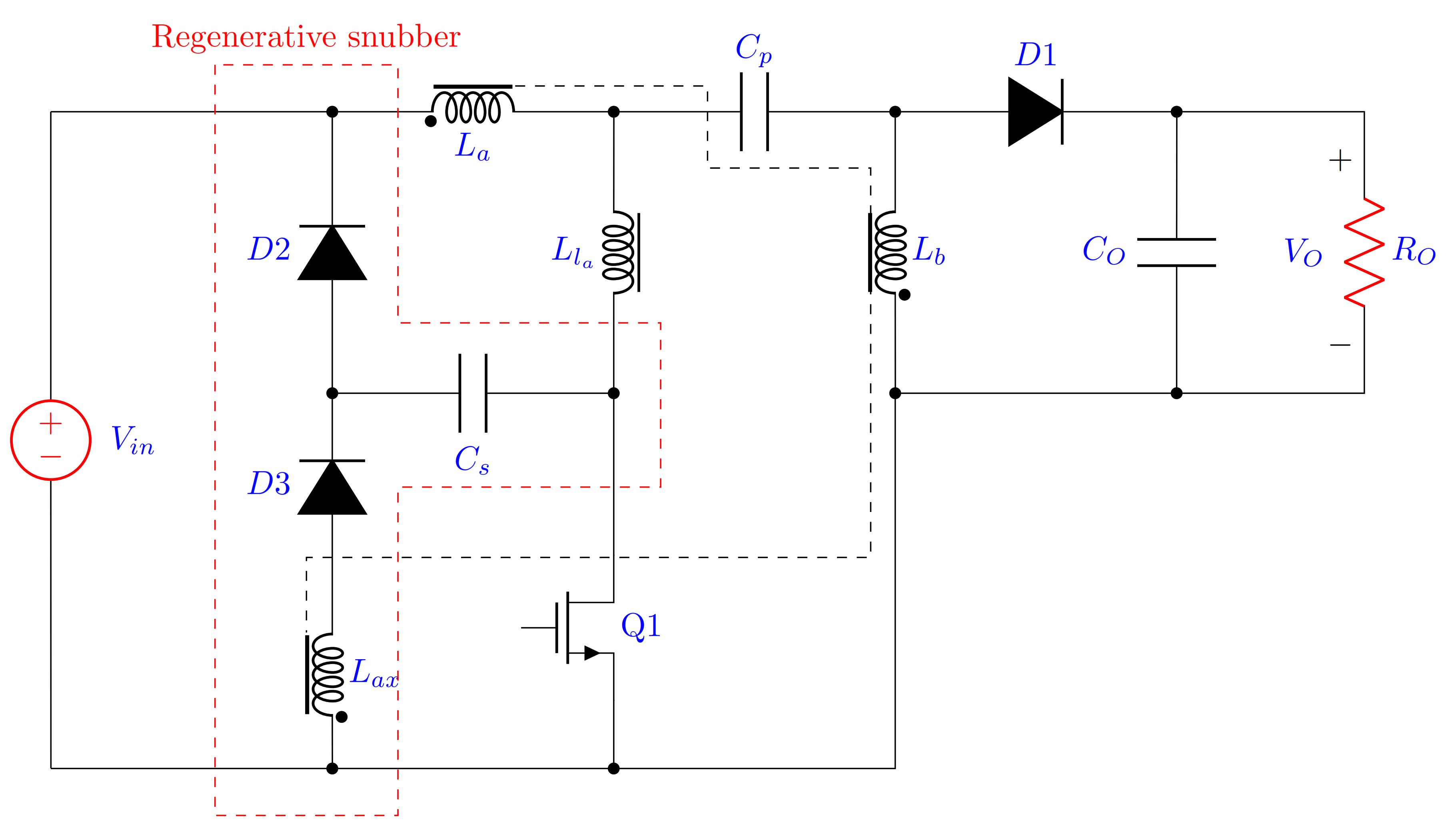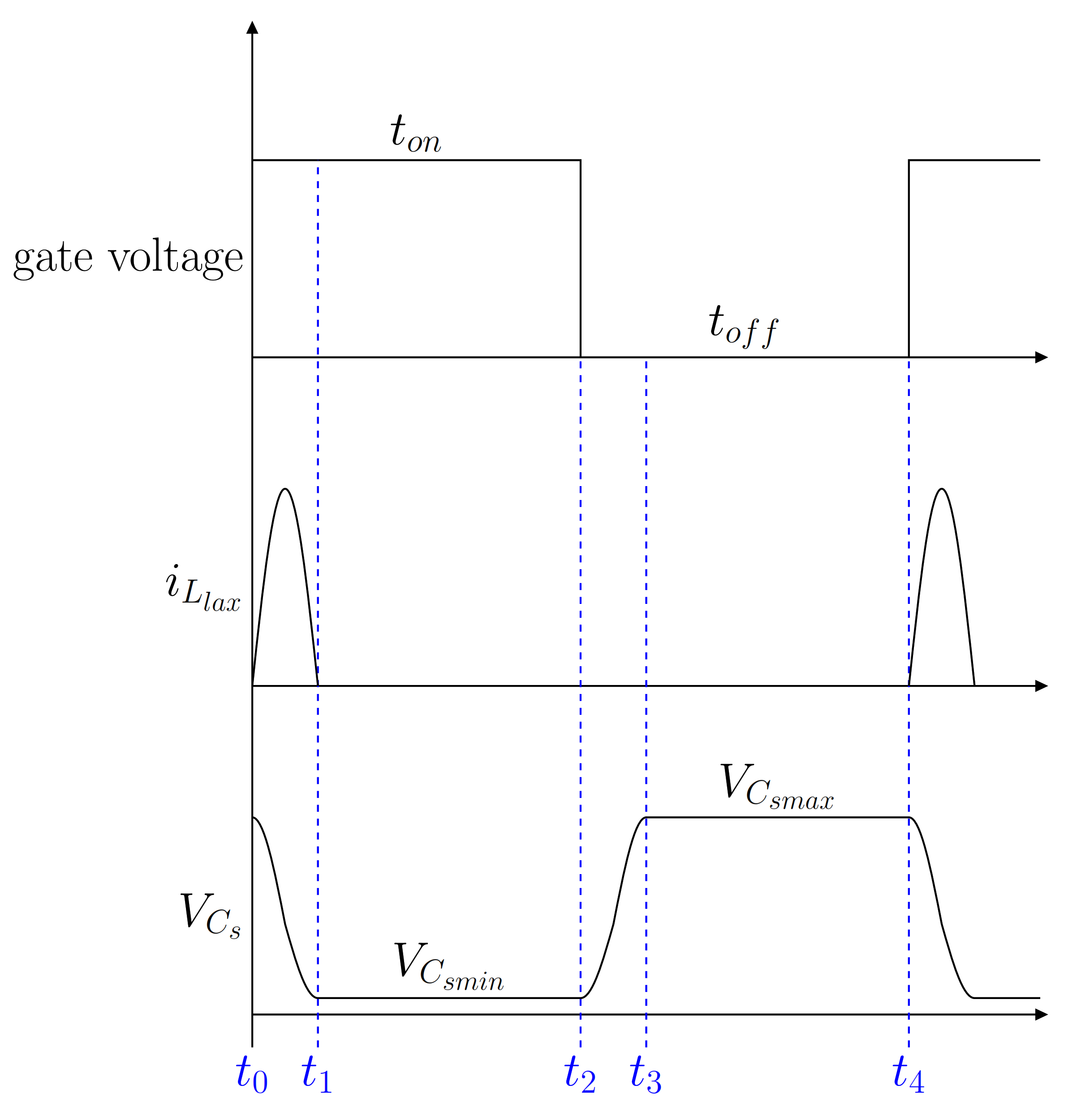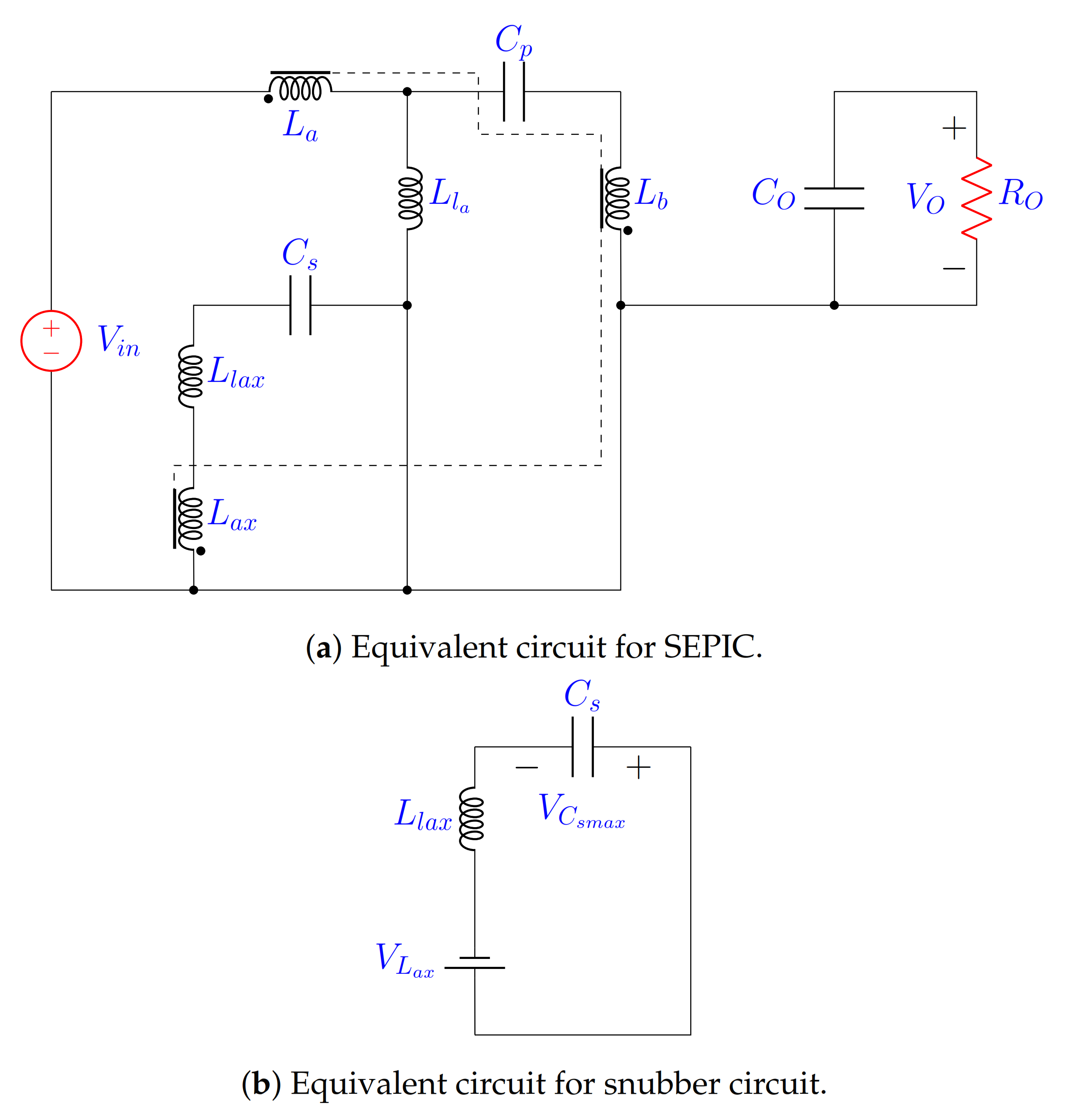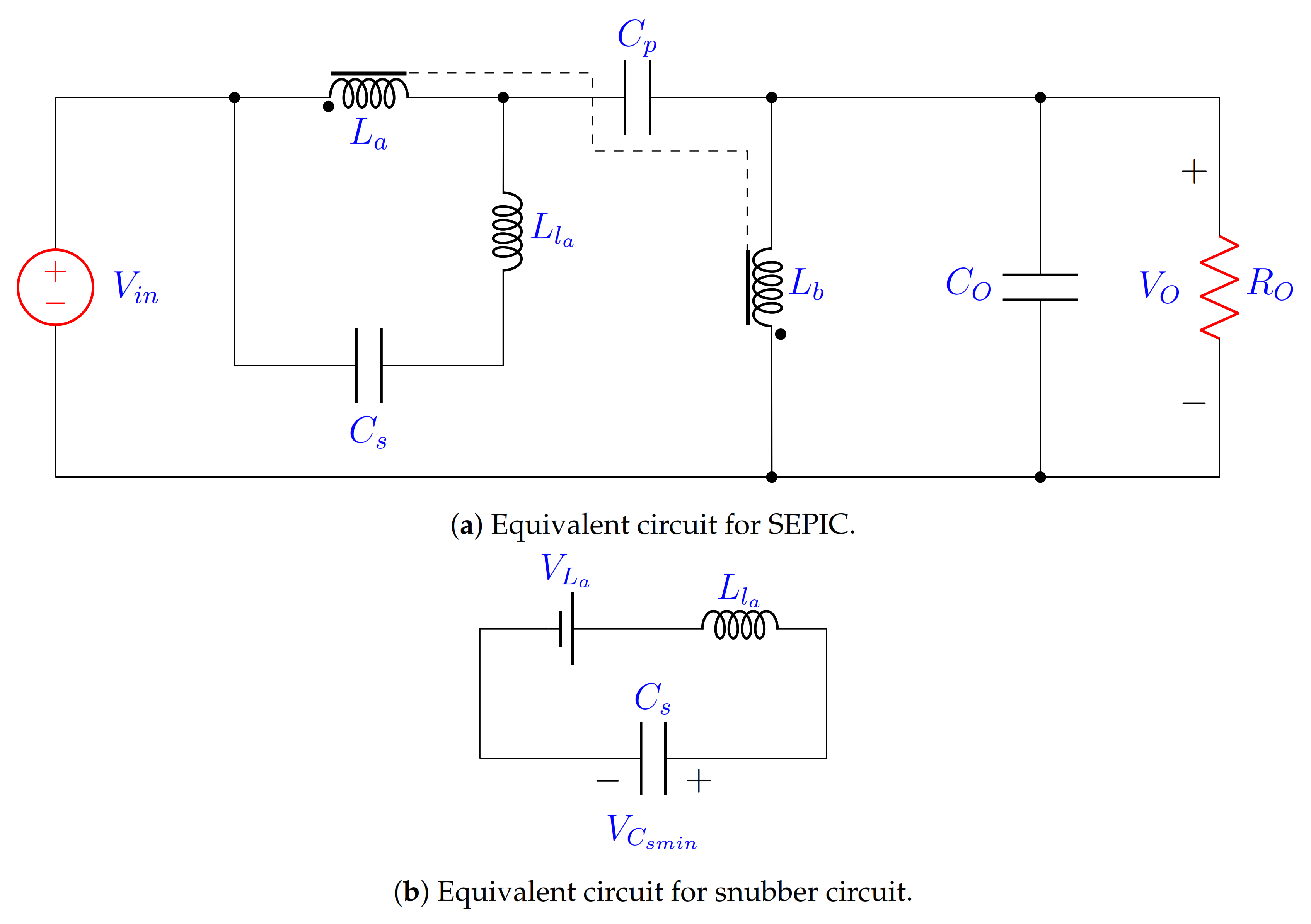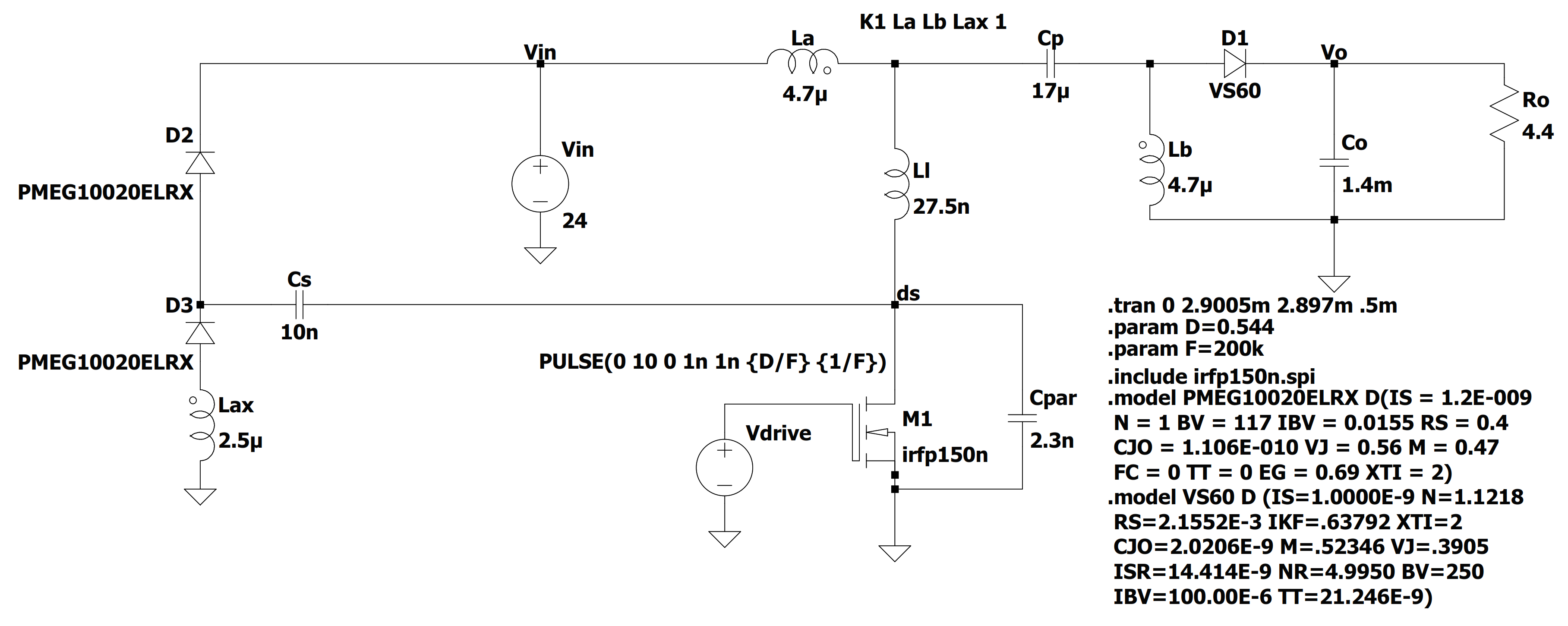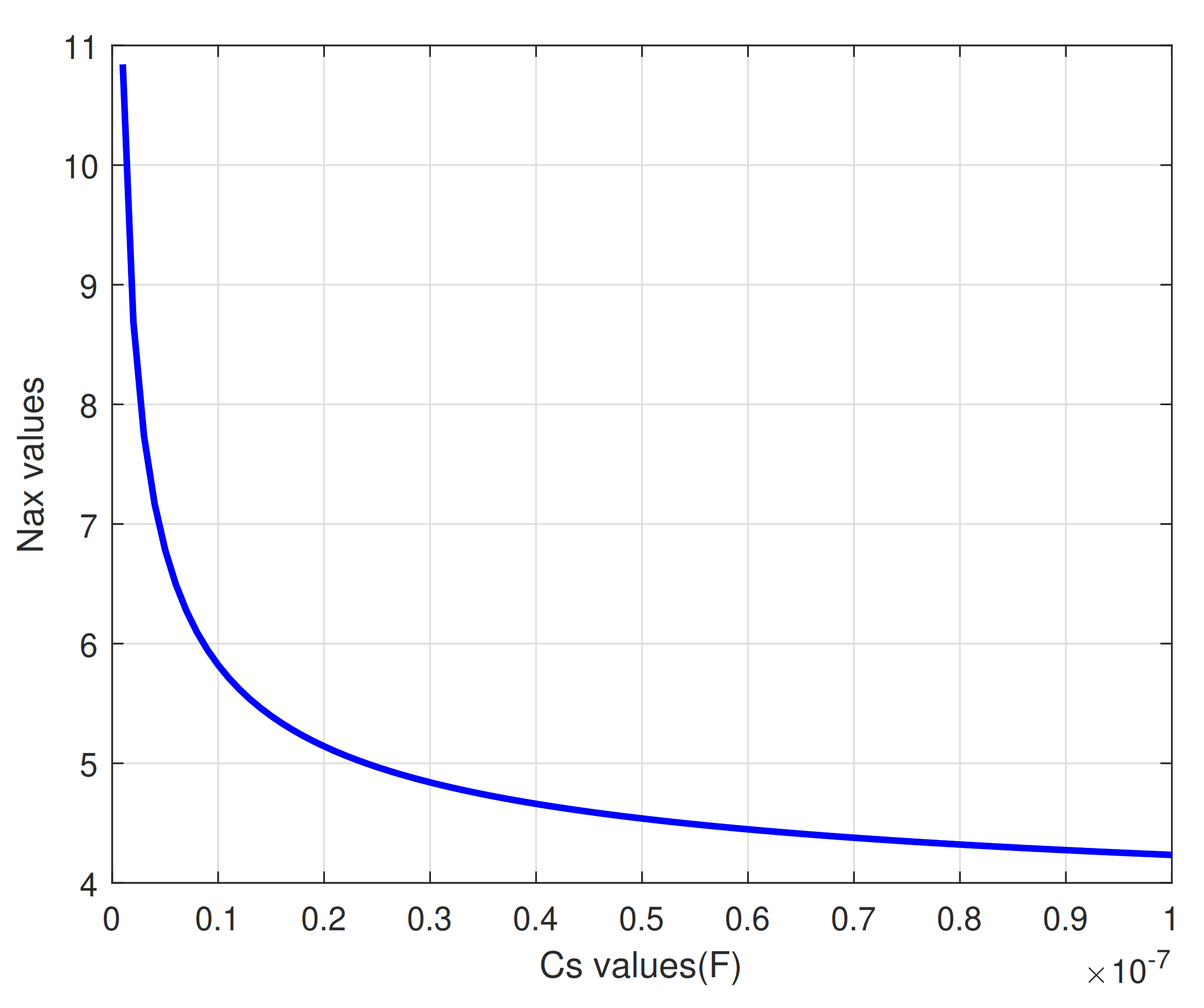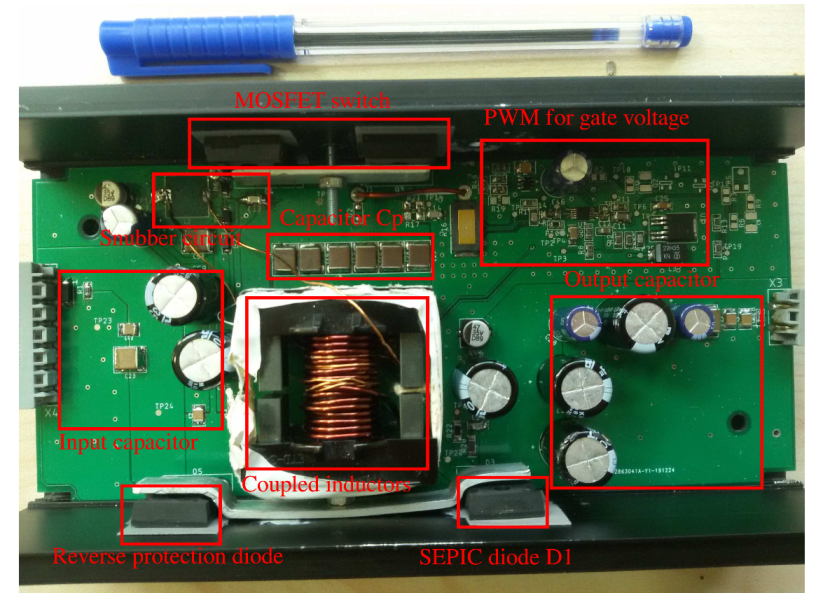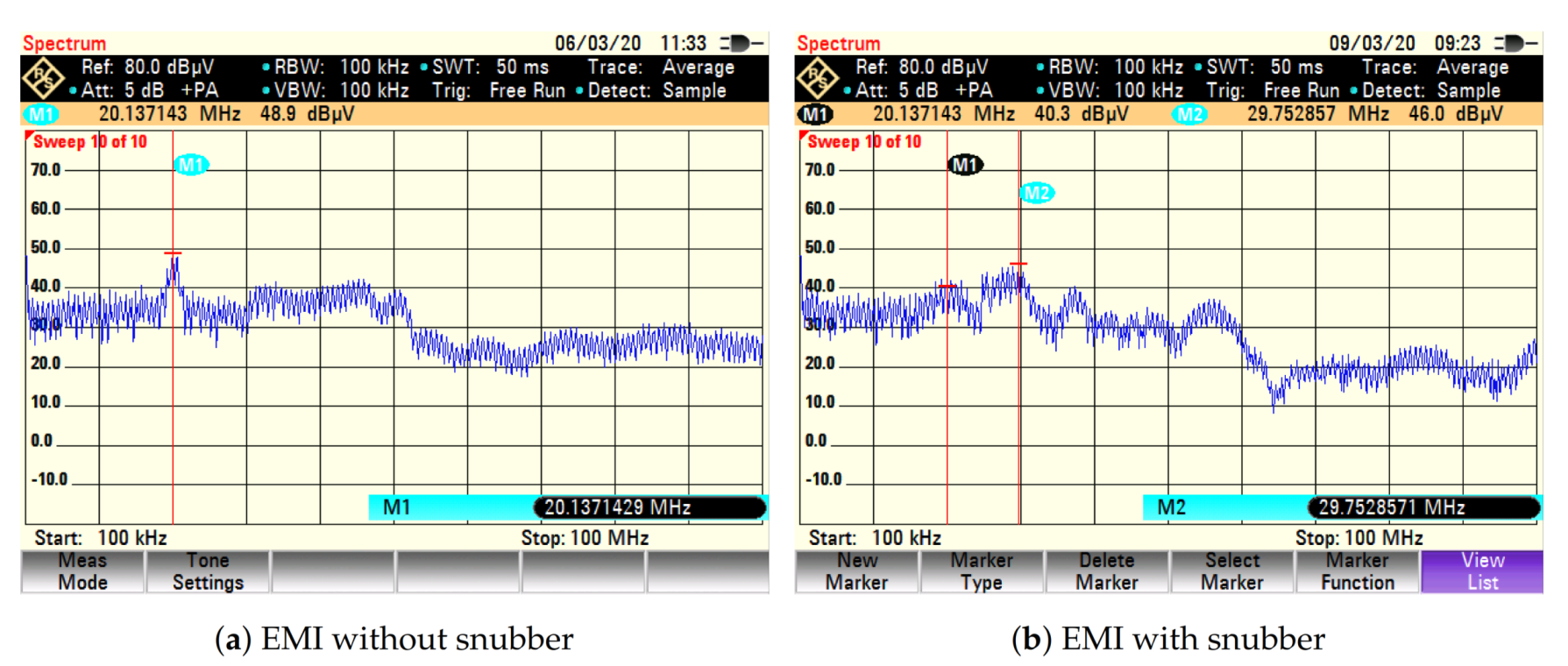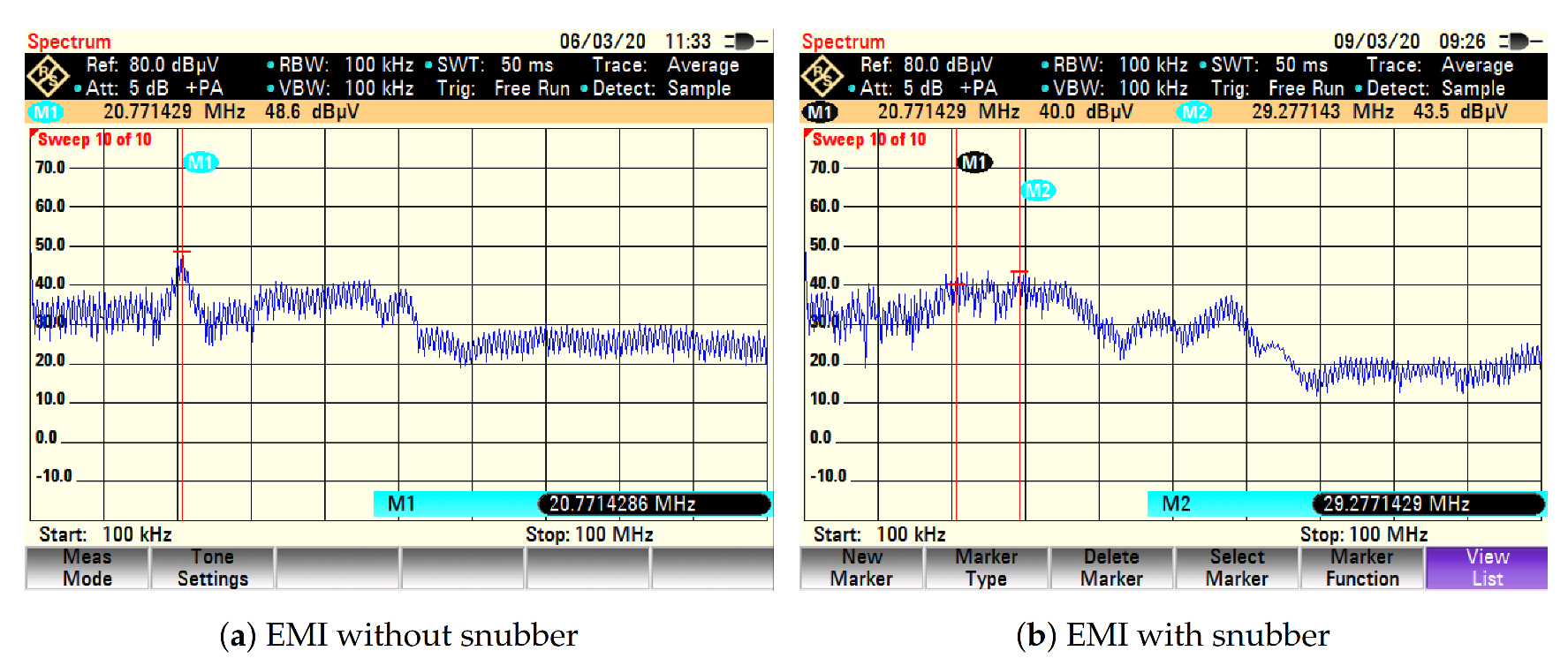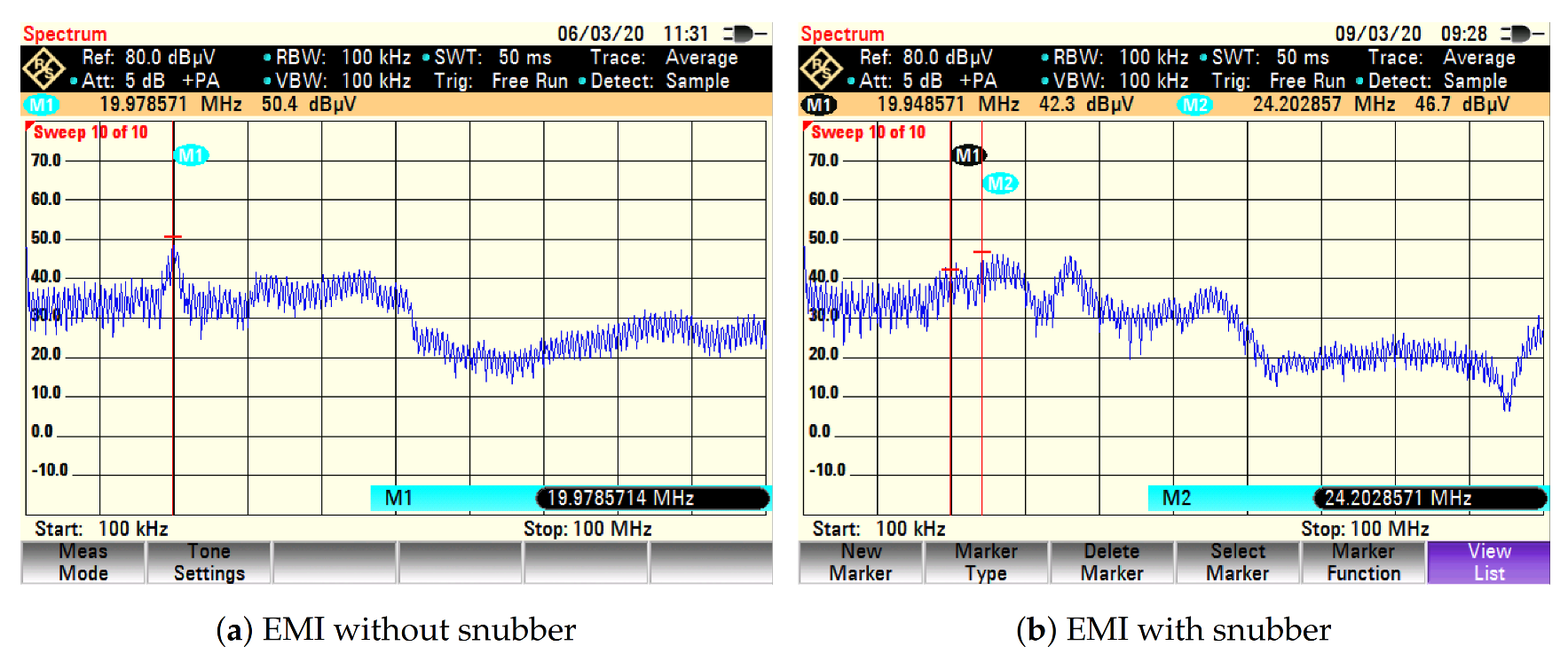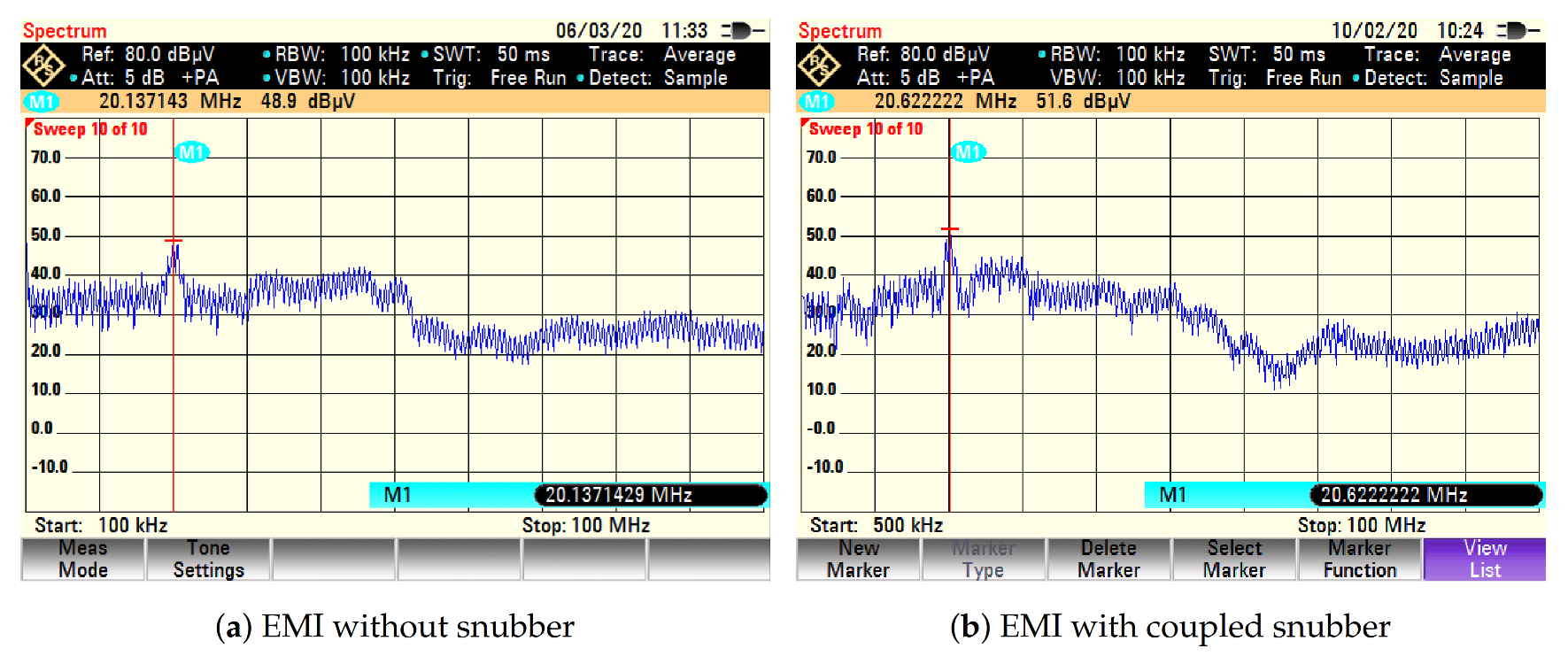1. Introduction
Over the past decades, research has been directed towards EV to improve the environmental conditions [
1]. EV systems depend on electric power as its energy source rather than the fuel like in conventional vehicle systems. The main components of the EV system are battery for energy storage, motor for traction, AC/DC converter to charge the battery and supply energy to the motor from the battery, and DC/DC converter to provide energy to the low-power components in the EV system. The current use of DC/DC converters with transformers or coupled inductors causes the following problems in the EV system; high voltage stress across the the power switch, increasing the converter area, and increasing the EMI [
2]. To design a DC/DC converter for an EV system, there are some constraints that should be considered: high efficiency, small volume, and low EMI [
3]. Several typologies of DC/DC converters are used in EV applications such as Buck converter, Boost converter, Buck-boost converter, and SEPIC converter.
SEPIC is considered a buck-boost DC/DC converter. It differs from the regular buck-boost converter such that the output voltage polarity in the SEPIC converter is non-inverting [
4]. SEPIC converter is designed using two separate inductors [
5]. However, using two coupled inductors rather than two separated inductors reduces the required inductance for the same inductor ripple current in half [
6,
7]. SEPIC converter with two coupled inductors is shown in
Figure 1, where
and
are the coupled inductors. Like most of the other DC/DC converters which contain a coupled inductors or transformer in their circuit, SEPIC converter suffers from the energy stored in the leakage inductance of the primary inductor. This energy causes a voltage stress on the switch transistor during the turn OFF period and may damage the Metal–Oxide Field–Effect Transistor (MOSFET) switch [
8]. To prevent that damage, a snubber circuit is used to create an alternative path for that energy and protect the MOSFET switch. Besides that, the ringing created from the resonance between the leakage inductance of the primary inductor and the parasitic capacitance of the MOSFET switch, increases the EMI of the converter at the ringing frequency [
9]. In addition, to protect the switch from the energy stored in the leakage inductance, snubber circuit reduces the EMI as presented in [
10,
11].
Snubber circuits are classified as dissipative and non-dissipative. The most commonly used dissipative snubber is the Resistor-Capacitor (RC) snubber. It consists of a capacitor and a resistor in series connected in parallel with the transistor [
12]. In this type of snubber, during the turn OFF period, the stored energy in the leakage inductance is transferred to the snubber capacitor through the snubber resistor. In the turn ON period, the snubber capacitor discharges that energy through the transistor. Another dissipative snubber is the Resistor-Capacitor-Diode (RCD) snubber, which differs from the RC snubber by containing a diode in parallel with the resistor. The operation of the RCD snubber is the same as the RC snubber operation, except in the RCD snubber during the turn OFF period, the energy is transferred to the capacitor through the diode not through the resistor [
13]. There is a trade off between the RC and the RCD snubbers. The RCD snubber decreases the power loss during the turn OFF period compared to the RC snubber. However, the RC snubber achieves more suppression for the over-voltage peak during the turn OFF period [
14]. Connecting the snubber circuit in parallel with the MOSFET switch causes more current stress on it [
13]. By connecting the snubber circuit in parallel with the primary inductor rather than the MOSFET switch, the current stress on the MOSFET switch is avoided [
15]. The performance of the snubber circuit does not change by connecting it in parallel with the primary inductor. A SEPIC converter with RCD snubber is shown in
Figure 2a.
A non-dissipative LC snubber is presented for flyback converter in [
16]. The snubber action is analyzed for four different operation modes. These modes differ from each other by when the energy stored in the snubber capacitor is returned to the supply. In mode 1, no energy is returned to the supply after stored it in the snubber capacitor during the turn OFF period. During the turn ON period, the snubber capacitor is discharged through the snubber inductor and the transistor. In mode 2, the energy in the snubber capacitor is returned to the supply during the turn ON period. In mode 3, the energy is returned to the supply during the turn ON and the turn OFF periods. In mode 4, the energy is returned to the supply in the turn OFF period. The voltage across the snubber capacitor determines in which mode the snubber operates.
The LC snubber has an advantage over the RC snubber, because it is able to return the stored energy in the leakage inductance through the snubber inductor to the supply rather than dissipating it like the RC snubber. On the other hand, an extra inductor used in this type of snubber increases the number of components. A SEPIC converter with an LC snubber is shown in
Figure 2b.
The regenerative snubber for flyback converter presented in [
17,
18] differs from the LC snubber, because it is based on three coupled inductors rather than the regular two coupled inductors or two winding transformer. The third coupled inductor or the auxiliary inductor is used as a snubber inductor instead of using a separate inductor like LC snubber. That reduces the number of required components and transfers the energy also to the secondary side during the turn ON period.
In this paper, a coupled inductor based LC regenerative snubber for SEPIC converter is proposed to minimize the switching stress on the transistor, as shown in
Figure 3. This method also reduces the Electromagnetic Interference (EMI) which occurs due to the switching activity. The rest of the paper is organized as follows. The operation of a SEPIC converter with regenerative snubber is analyzed and design constraints for the snubber component values are determined in
Section 2. In
Section 3, the advantages of regenerative snubber for SEPIC converter are verified by simulation and experimental results. Finally, a conclusion about the results of using the regenerative snubber for SEPIC converter is presented in
Section 4.
2. Analysis of LC Regenerative Snubber for SEPIC Converter
For the SEPIC converter with regenerative snubber shown in
Figure 3, there are four states in each operation cycle, as shown in
Figure 4. Two of these states are in
, which is the turn ON period, and the other two states are in
, which is the turn OFF period. The snubber circuit is active at the first state of the turn ON period from
to
, and at the first state of the turn OFF period from
to
. At the second state of the turn ON period from
to
and at the second state of the turn OFF period from
to
, the SEPIC converter acts like a regular SEPIC converter without any effects from the snubber circuit. In analyses, voltage drops across diodes and transistor are neglected. The leakage inductance at the primary side and at the auxiliary winding are taken into account.
2.1. Operating State of LC Snubber Circuit
As shown in
Figure 4 , the first state of the turn ON period starts at
when the MOSFET switch is turned on. In this state,
and
are off,
is on, and the voltage across
is
which is the maximum voltage. During this state,
discharges through the MOSFET switch and
, where
is the auxiliary inductor. In this state, as presented in [
18] for the flyback converter, the voltage across the auxiliary inductor is equal to the reflected voltage from the primary inductor only. However, in the SEPIC converter, the voltage across
is equal to the reflected voltage from the primary and the secondary inductors, this is one of the main differences between the regenerative snubber performance in the SEPIC and in the flyback converters. This state ends at
, when
becomes off and the current through
becomes zero. The equivalent circuit of the SEPIC with regenerative snubber in this state is shown in
Figure 5a. The equivalent circuit for the snubber circuit is shown in
Figure 5b, where
is the leakage inductance at the auxiliary side and
is the voltage across
.
is the leakage inductance at the primary side,
is the number of turns for
,
is the number of turns for the primary side
, and
is the number of turns for the secondary side
. Suppose that the SEPIC is designed to have
, the voltage of the leakage inductance at the auxiliary side is obtained as
The time constant
for the equivalent circuit in
Figure 5b is
The impedance of the leakage inductance
is
The current through
equals to
The voltage across
equals to
when
,
reaches
. As shown in (6) and
Figure 4,
when
, by substituting that in (
7)
The power consumption in
during this state is
where
is the average current of
during this state.
is the voltage drop across
D3.
equals to
where
T is the switching time. After
turns off at
, the second state in the turn ON period begins. In this state, the snubber circuit does not affect the performance of the SEPIC and the converter acts like regular SEPIC in the turn ON period until the turn OFF period starts at
when the MOSFET switch is turned off.
At the first state of the turn OFF period, the snubber is active. In this state,
and
are on, and
is off. The equivalent circuit for the SEPIC converter and for the snubber circuit in this state are shown in
Figure 6a,b, respectively.
is the reflected voltage from the secondary side to the primary side and it is equal to
. The voltage across
at the beginning of this state is
. This state ends at
when
reaches
, that happens when the current through the leakage inductance
.
The time constant
for the equivalent circuit in
Figure 6b is
The impedance of the leakage inductance
is
The current through the leakage inductance
equals to
where
I is the peak of the magnetizing current. Suppose that
is selected to have
, the current through the leakage inductance
is written as
The voltage across
equals to
From (
15),
reaches
at
and it equals to
By taking
into account, substituting (
16) in (
8) leads to
The power consumption in
during this state is
where
is the average current of
during this state.
is the voltage drop across
.
equals to
After the current through the leakage inductance becomes zero at , turns off and the second state of the turn OFF period starts. During the steady state of this period, charges to the input voltage . This leads to that the voltage across MOSFET during this period equals to the summation of the input voltage and the output voltage. In this state, the converter acts like regular SEPIC converter in the turn OFF period without any effects from the snubber circuit until when the MOSFET switch is turned on again. All of these states are repeated in each cycle.
2.2. Components Sizing
During the first state of the turn ON period,
drops to
, after that
turns off. Moreover, during the turn OFF period to make
on,
should be greater than
[
18]. From that, and by solving the following inequality,
Furthermore, by solving the following inequality using (
16) and (
17),
Moreover, as mentioned in
Section 2 that
should be selected to have
, by solving the following inequality taking (
20) into consideration and using (
17),
where
D is the duty cycle. In the first state of the turn ON period,
reaches
when
, which means half of the time constant. This should happen within the turn ON period, this leads to
By using (
22) and (
24), the upper and lower limits for
are determined. Moreover, by using (
28) and (
30), the upper and lower limits for
are obtained. From the previous constraints, the value of the leakage inductance of the primary
is very critical and important to determine the limits of
and
. To calculate the leakage inductance value, the value of the parasitic capacitance of the switch should be known. If it is not known, to calculate it, the frequency of the ringing should be measured. It equals to
where
is the parasitic capacitance. After measuring the ringing frequency, an additional capacitor should be connected in parallel with the parasitic capacitance and then new ringing frequency should be measured. The new frequency equals to
where
is the additional capacitor. By using (
31) and (
32), the parasitic capacitance is calculated and it equals to
After calculating
, the leakage inductance
is calculated by rearranging (
31)
3. Simulation and Experimental Results
LTSpice is used to simulate the SEPIC converter with regenerative snubber. Component parameters used in the simulation are shown in
Table 1. The simulation setup is shown in
Figure 7.
From the design constraints illustrated in the
Section 2, the values of
and
are related to each other. From (
22), the lower limit for
is
By drawing (
24) using the above constraint for the lower limit of
as shown in
Figure 8, the chosen pair of
and
values should be under the graph. To avoid the sensitive areas, the optimum values of
and
are found to be in the area under the graph and bounded by
25 nF and
6.5. The chosen pair for (
,
) is (10 nF, 5).
The simulation results of the voltage across the MOSFET switch of the SEPIC converter without regenerative snubber and with non-coupled and coupled regenerative snubber for
24 V are shown in
Figure 9. To ensure that the regenerative snubber has the same effect on the SEPIC converter with different values of
, the voltage across the MOSFET switch without snubber and with snubber for
28 V and
22 V are depicted in
Figure 10 and
Figure 11, respectively. Without coupling of snubber inductance to SEPIC inductors, the improvement is limited, as shown in
Figure 9b,
Figure 10b, and
Figure 11b. The coupling between snubber inductance and SEPIC inductors contribute significant reduction of ringing, as shown in
Figure 9c,
Figure 10c, and
Figure 11c. Comparison between simulation results is shown in
Table 2 where Avg. P is the average power consumption in the MOSFET during turn OFF period,
D is the duty cycle,
is the voltage overshoot across the MOSFET, and
is the steady-state voltage across the MOSFET during turn OFF period. Using the regenerative snubber, the average power consumption in the MOSFET, the overshoot voltage during the turn OFF period and the required time to reach the steady state are all reduced.
For the experiment, a prototype for SEPIC converter is built, as shown in
Figure 12. The voltage across the MOSFET switch in the turn OFF period without the regenerative snubber and with the regenerative snubber experimentally for
24 V are shown in
Figure 13a,b, respectively. The regenerative snubber reduces the stress on the switch by reducing the ringing and suppressing the voltage surge by 16 V. Moreover, the voltage across the MOSFET switch of the SEPIC during the turn OFF period with snubber and without snubber for different input voltages are shown in
Figure 14 and
Figure 15, respectively. The voltage on the MOSFET switch without coupled inductance in the regenerative snubber is shown in
Figure 16b. Although the peak voltage is reduced compared to the one without snubber circuit, the time for settling due to the ringing does not change significantly.
Reverse protection diode and SEPIC diode are selected as PN junction diode. Although PN junction diode has higher forward voltage drop than a schottky diode, it has lower reverse current leakage at high temperature. The voltage drop on these diodes is around 0.9 V. Therefore, for a 4.4 load these diodes contribute 11 W of power loss. The ferrite core is based on N87 material and has 4 W of power loss. The power loss due to the series resistance of inductors is 1 W. The conduction and switching losses of the MOSFET switches are 1 W and 3 W, respectively. The gate driver circuit including its low-dropout regulator contributes 1.5 W of power loss. The rest of the circuit contributes less than 0.5 W. Therefore, for 4.4 load the output power is 131 W and total power loss is 22 W. This results in 85 % efficiency. Since snubber circuit improves switching losses which is only 14 % of the total loss, the effect of snubber circuit on the efficiency is limited.
To measure EMI for the SEPIC converter, Rohde & Schwarz FSH8 spectrum analyzer is used. The SEPIC converter without regenerative snubber has a peak at the ringing frequency which is 20 MHz, as shown in
Figure 17a. After using the regenerative snubber as shown in
Figure 17b, the peak at the ringing frequency is suppressed by 8 dB. On the other hand, another peak appears at 29.75 MHz, but still less than the peak without regenerative snubber by 2.8 dB.
The EMI for the SEPIC without regenerative snubber and with regenerative snubber for input voltage
28 V and 22 V are shown in
Figure 18 and
Figure 19, respectively. For
28 V as shown in
Figure 18a, the converter has a peak of 48.6 dB at the ringing frequency. In
Figure 18b, using the regenerative snubber reduces that peak to 40 dB. Moreover, at high frequency, the EMI is reduced by 10 dB. The same thing happens for
22 V, as shown in
Figure 19, where the converter has a peak of 50.4 dB at the ringing frequency. Using the regenerative snubber reduces the peak at the ringing frequency to 42.3 dB. Moreover, EMI at high frequency is reduced by 10 dB. EMI for SEPIC with non-coupled regenerative snubber is shown in
Figure 20 which does not reduce the EMI compared to the coupled regenerative snubber. Performance measurement results with regenerative snubber and without regenerative snubber for different input voltages
24 V, 28 V, and 22 V and with non-coupled regenerative snubber for
24 V are summarized in
Table 3.

